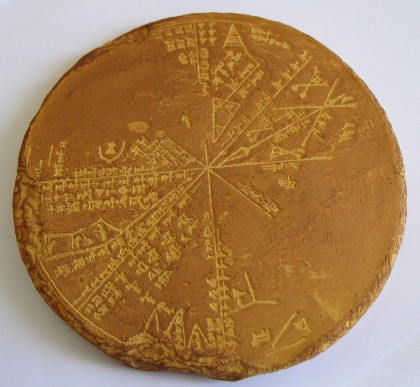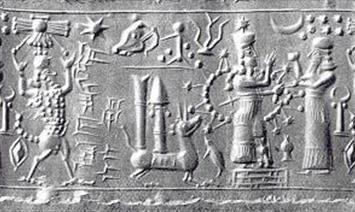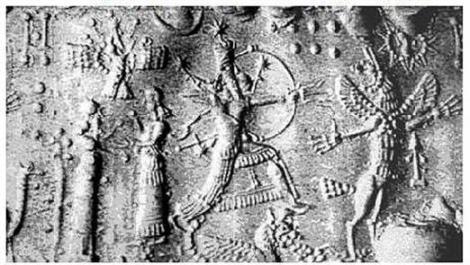
Los días de la semana deben su nombre a los siete astros conocidos por la astronomía clásica, y su denominación en castellano proviene del latín, dado quelos astros a su vez fueron nombrados en relación a las divinidades de la mitología romana: Sol, Luna, Marte, Mercurio, Júpiter, Venus y Saturno.
Pero no fueron los romanos quienes idearon este esquema, sino que al absorber la cultura helénica, que ya lo utilizaba, sólo sustituyeron a los dioses griegos Ares, Hermes, Zeus, Afrodita y Crono por sus equivalentes locales.
A su vez, los pueblos germánicos adaptaron el sistema introducido por los romanos pero también decidieron utilizar sus dioses autóctonos en reemplazo de las deidades romanas (con la excepción del Sábado) en un proceso que se ha denominado Interpretatio germánica, quedando entonces como Tiu, Woden, Thor y Freya (Fria), ya que no sustituyeron a Saturno.
De esta manera, los días de la semana quedaron definidos de la siguiente forma:
- Domingo: En inglés antiguo, Sunnandæg, que significa “día del sol“, traducción de la frase en latín dies Solis. Tanto en inglés como en germánico se preserva el término original pagano (Sol) mientras que en los idiomas romances, han cambiado su nombre por “el día del señor”, basado en la expresión eclesiástica en latín dies Dominica. Tanto en la mitología germánica como nórdica, el Sol es personificado como una diosa, Sunna/Sól.
- Lunes: En inglés antiguo, Mōnandæg, que significa “día de la Luna“, traducción del nombre en latín dies lunae. En la mitológica germánica del norte, la Luna es personificada por un dios, Máni.
- Martes: En inglés antiguo, Tīwesdæg que significa “día de Tiw“, el dios germánico de la guerra y el cielo. Su equivalente nórdico era Týr, el romano eraMarte y el griego Ares. La expresión latina dies Martis, significa “Día de Marte“.
- Miércoles: En inglés antiguo, Wōdnesdæg en referencia al dios germánicoWodan (denominado Óðinn en los pueblos nórdicos), el dios líder de la “cacería salvaje”, prominente también entre los anglo-sajones. Mercurio es el dios romano del comercio, los viajes y la ciencia, siendo además el mensajero de los dioses. Su equivalente griego es Hermes, quien sirve también como el conductor de los muertos al Hades. Tanto Wodan como Mercurio eran considerados guías del alma después de la muerte, en sus mitologías respectivas.
- Jueves: En inglés antiguo, Þūnresdæg, que significa ‘día de Þunor’. Þunorsignifica “trueno” o su personificación, el dios nórdico denominado en inglés moderno Thor. De manera similar en alemán Donnerstag (‘día del trueno‘) y en escandinavo Torsdag (‘día de Thor‘). El término en castellano Jueves, proviene del latín Iovis (traducción de Júpiter), siendo dies Iovis, “día de Júpiter“. Asimismo, IúPiter, en latín arcaico era una contracción de Iovis Páter: ‘padre del cielo’. El equivalente griego de Júpiter (el supremo dios romano) es Zeus(el principal dios de la mitología griega y dios de los cielos) cuyos atributos son el águila, el rayo (como Thor) y el cetro.
- Viernes: En inglés antiguo, Frīgedæg, que significa el día de la diosa nórdicaFríge. Su equivalente germánica Freya era la diosa del amor, la belleza y la fecundidad. Su equivalente griego es Afrodita y el romano es Venus. El nombre nórdico del planeta Venus era Friggjarstjarna, ‘estrella de Frigg‘.
- Sábado: Este es el único día de la semana que mantiene su origen romano en inglés, designado en referencia al dios romano Saturno, el dios romano de la agricultura, asociado con el Titan Cronos, dios griego que gobernó el universo hasta ser destronado por su hijo Zeus. Su denominación anglosajona original era Sæturnesdæg. El escandinavo Lørdag/Lördag deriva del nórdico antiguolaugardagr, literalmente “día de lavado“. La palabra Samstag deriva del nombre del Shabbat.
En resumen:
| Español | Inglés | Significado | Planeta | Dios local |
| Sábado | Saturday | Saturn’s Day | Saturno | Cronos/Saturno |
| Domingo | Sunday | Sun’s Day | Sol | |
| Lunes | Monday | Moon’s Day | Luna | |
| Martes | Tuesday | Tiu’s Day | Marte | Ares/Marte/Tiu |
| Miércoles | Wednesday | Woden’s Day | Mercurio | Hermes/Mercurio/Woden |
| Jueves | Thursday | Thor’s Day | Jupiter | Zeus/Júpiter/Thor |
| Viernes | Friday | Freya’s Day | Venus | Afrodita/Venus/Freya |
Etimología de las palabras “dios” y “día”
En español, al igual que en las otras lenguas romances, la palabra «dios» viene directamente del latín deus, ‘deidad, dios’. El término latino deriva a su vez del indoeuropeo deiwos, de la raíz deiw (dyu), ‘ser de luz, de blancura, de esplendor’, de la que deriva asimismo el término griego Zeus. De hecho, la palabra española dios es idéntica en pronunciación a la griega Diós, forma genitiva de Zeus. De esta misma raíz indoeuropea deriva la palabra en latín dies (‘día’) y el término griego para ‘visible, patente’.
La forma indoeuropea deiw-os aparece en muchas familias indoeuropeas sistemáticamente asociado a pəter (‘padre’) en la forma compuesta dyeus-pəter, con alusión al “dios del cielo” y que significa literalmente “padre-día”. La raíz indoaria dyē-, dįā, dei- puede ser vertida como “bóveda celeste”, “brillo”, “luz” o “resplandor”, por lo que la palabra “día” estaría emparentada con “dios”. En sánscrito tardío la forma aparece como Dyaus Pitar, mientras que en griego se traduce como Zeus Pater(genitivo dios, y acusativo día), análoga a la latina Iu Piter (Júpiter) de donde proviene la palabra Jueves.
El latín deus, en otras lenguas romances, derivó en deus (gallego y portugués), dieu(francés), dio (italiano), déu (catalán), entre otras. Pese a su parecido con el término griego análogo, theós, (‘deidad, dios’), este deriva de la raíz indoeuropea dhēs-, de significado desconocido, pero que originó en latín palabras de significado inicialmente religioso como feria o fanatismo.
En las lenguas germánicas la palabra para designar a la deidad proviene de la raíz protogermánica ǥuđan, de donde vienen god (inglés) o gott (alemán). En las lenguas semíticas, incluido el hebreo, el término más extendido es El (ʾl), del que derivan, entre otros, el plural hebreo Elohim (אֱלֹהִ֔ים, ‘dioses’, generalmente traducido como ‘Dios’ o ‘Señor’) y el árabe Allāh (الله, Alá).
Por otro lado, el término náhuatl para “dios” es teotl, que no obstante su enorme similitud fonética y significativa con el griego theós, no tienen para la ciencia formal ninguna conexión. Más aún es de tener en cuenta que la terminación “tl” es propia de la lengua náhuatl (se adiciona normalmente a la terminación de las palabras) y por tanto debería desconsiderarse para una comparación objetiva, quedando entoncestheós y teo, términos que significan lo mismo y se pronuncian igual pero supuestamente sin ningún origen común…
LOS SUMERIOS Y LOS PLANETAS
Pero los primeros que realmente identificaron a estos cinco planetas visibles para el ojo humano – Mercurio, Venus, Marte, Júpiter y Saturno – y los nombraron por sus dioses fueron, una vez más, los sumerios.
Ellos fueron los primeros en identificar que había “estrellas errantes” que durante todo el año avanzaban en una dirección pero, durante algún tiempo, deshacían el camino andado y retrocedían – explicando de esta forma el movimiento retrógrado de los planetas -, por lo que entendieron que no se trataba de estrellas comunes sino de otro tipo de astros.
De hecho, la palabra “planeta” proviene del griego “planētēs” que significa «vagabundo, errante», debido a que en la antigüedad (siguiendo la teoría geocéntrica de Aristóteles en la cual la Tierra era considerada el centro del cosmos), observaron que las “cinco errantes” no describían una órbita regular. Es decir, consideraron a estos astros “errantes” (y así los nombraron), tal como lo concluyeron los sumerios miles de años antes.
En la cultura mesopotámica, la vinculación entre los planetas y los dioses era:
- SOL: Utu en sumerio, Shamash en babilonio, era el dios del Sol. Asimismo como dios del orden y de la Ley, es quien entrega a Hammurabi el primer código de leyes conocido de la humanidad. Se le representaba con un disco solar de ocho puntas o mediante una figura masculina de la que emanaban llamas de los hombros.
- LUNA: Nannar en sumerio, Sin en babilonio, era el dios de la Luna, tradicionalmente adorado en la antigua ciudad de Ur. Enlil era citado normalmente como su padre. Se le representaba mediante un creciente lunar. No tuvo un único centro de culto pero el templo E-Kishnugal en Ur era uno de los principales.
- MARTE: Nergal era el dios del inframundo y de las plagas. Hijo de Enlil y consorte de Ereshkigal, Nergal era el principal representante de Marte entre los mesopotámicos que, desde época temprana tenía una identidad malevolente como señor de los muertos, portador de la pestilencia y de la guerra. El centro de culto principal era el templo E-meslam, en Kutu, Babilonia.
- MERCURIO: Nabu es el dios babilonio de la sabiduría y la escritura, adorado por los babilonios como el hijo de Marduk y de su consorte, Zarpanitum, y como el nieto de Enki. En la astrología tardía de Babilonia, Nabu (en la Biblia como “Nabo”) estaba conectado con el planeta Mercurio. Como dios de la sabiduría y la escritura, fue equiparado por los griegos tanto a Apolo como a Hermes, siendo el último identificado por los romanos con su propio dios Mercurio.
- JÚPITER: Marduk era el dios supremo de Babilonia, pastor de las estrellas y amo del viento y las tormentas. Marduk (en la Biblia Merodach מְרֹדַךְ) era hijo de Enki, y su hijo era el dios Nabu. Astronómicamente se le asociaba con el planeta Júpiter, al haber asumido casi todos los poderes y características de Enlil. Esta relación entre Júpiter y el dios principal del panteón sería traspasada a los griegos.
- VENUS: Inanna para los sumerios e Ishtar para los babilonios, es la diosa del amor, el sexo, la belleza, la fertilidad y la guerra. Diosa muy popular entre todos los pueblos semitas, también conocida en otros lugares como Anat, Astarté o Teshub, era representada usualmente con una estrella de 8 puntas. Astronómicamente se la identificaba con el planeta Venus, relación que fue traspasada a la mitología grecolatina. Sin un lugar de culto central, destacaba el E-ana (“Casa del Cielo”) de Uruk.
- SATURNO: Ninurta (hijo de Enlil) es un dios agrícola y guerrero al cual se le representa portando un arco y flechas o un arado. El culto a Ninurta se remonta a los orígenes de Sumeria, en donde era el dios de Nippur, con centro en el E-shumesha. Astronómicamente Ninurta aparecía en épocas tempranas asociado con Saturno.

Tríada Astral Semita: Ishtar, Sin y Shamash, eran los miembros de la “Tríada semita” de dioses con relaciones celestes que se incorporó al panteón mesopotámico desde el Periodo Acadio.
LOS SUMERIOS Y LA ASTRONOMÍA
El estudio del movimiento de los cuerpos celestes les ayudó a los sumerios a definir la eclíptica, que es el círculo aparente que traza el Sol sobre la esfera celeste durante su trayectoria anual, a partir del cual desarrollaron un calendario solar, que se dividía en dos estaciones: verano e invierno. El verano empezaba en el equinoccio de primavera y el invierno en el de otoño. El día de Año Nuevo, uno de los más importantes para esta civilización, tenía lugar en el equinoccio de primavera.
También crearon un calendario lunar, gracias al cual asignaron 12 meses al año, y para ajustar este calendario con el solar, añadían un mes extra cada cuatro años. Prestaron especial atención al estudio de la Luna, llegando incluso a predecir cuándo tendrían lugar los eclipses. Era tal su dominio de las matemáticas que asignaron 360° a la circunferencia y dividieron el día en 24 horas. Cada hora la dividieron en 60 minutos y cada minuto en 60 segundos.
Los primeros mapas celestes también corrieron a cargo del pueblo sumerio y bautizaron las estrellas más brillantes del firmamento. Pero además de esto, inventaron el Astrolabio (en griego “buscador de estrellas”) para poder determinar la posición de las estrellas sobre la bóveda celeste.
Es habitual creer que el origen de las constelaciones se lo debemos al saber griego, pero fueron en realidad los sumerios quienes dividieron la eclíptica en 12 partes y asignaron un símbolo a cada una de ellas, siendo estos luego adoptados por los griegos, y a través de ellos, llegaron hasta nuestros días.
LOS REGISTROS ASTRONÓMICOS SUMERIOS
Las tablillas Mul-Apin son la principal fuente de conocimiento astronómico mesopotámico que existe. Datan del periodo asirio, de alrededor del 687 AEC, aunque los cálculos de las salidas heliacas de varias constelaciones han hecho proponer a muchos investigadores una fecha de origen más cercana al 2000 AEC.
Su nombre se debe a que la primera constelación que aparece es precisamente Mul-Apin, el “arado”. Todas las constelaciones llevan delante en caracteres cuneiformes el determinativo Mul, en sumerio “estrella”, para identificarlas como tales, aunque la lista también incluye planetas.
articulo publicado en--http://reydekish.com/2015/03/19/la-astronomia-y-los-sumerios/


No hay comentarios:
Publicar un comentario
Nota: solo los miembros de este blog pueden publicar comentarios.